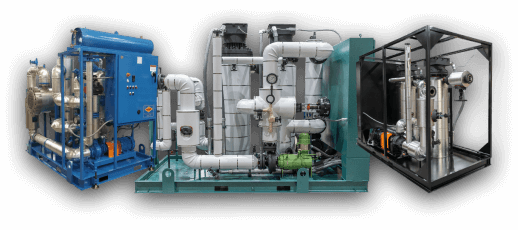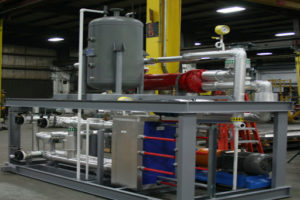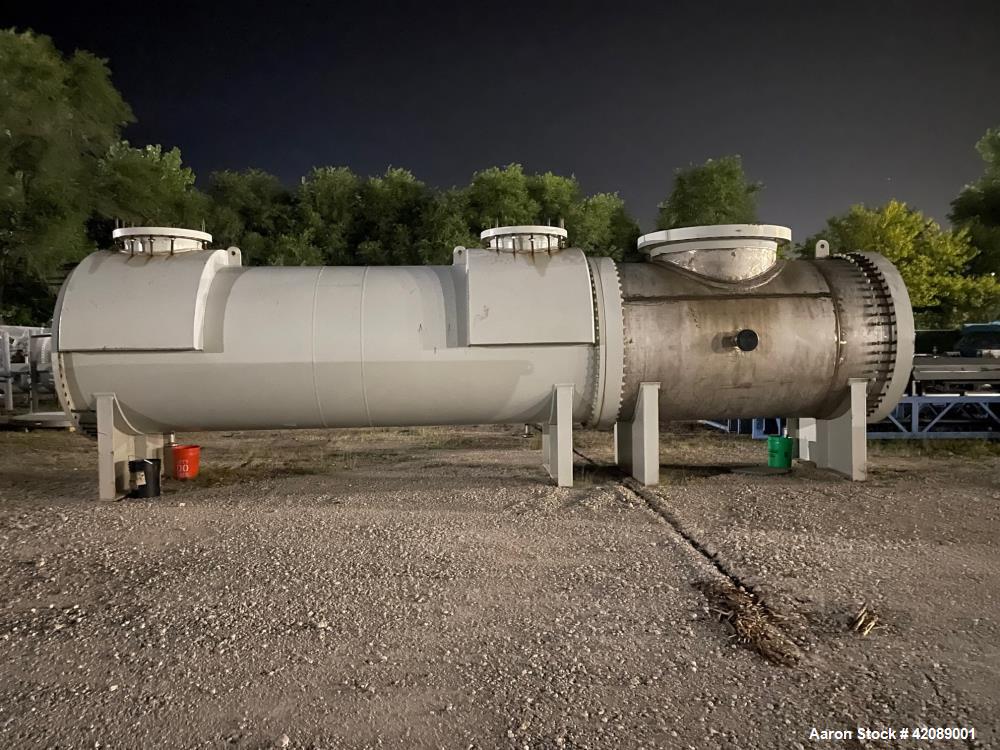Technologies in Heat Transfer Systems: What You Need to Know for Optimum Performance
Developments in Heat transfer systems are changing efficiency throughout different markets. Advanced products like graphene and nanofluids assure substantial enhancements in thermal conductivity. The integration of IoT and machine discovering uses opportunities for real-time tracking and boosted power effectiveness. However, the landscape of thermal administration is swiftly evolving (DVS Heat Transfer Systems). Comprehending these growths is important for accomplishing suitable system performance and sustainability in the future. What particular innovations are shaping this change?
Arising Materials for Boosted Heat Transfer

Advanced Heat Exchanger Layouts
While standard Heat exchangers have served their purpose in various applications, advanced styles are now arising to fulfill the boosting needs for performance and efficiency. These ingenious layouts, such as plate, shell-and-tube, and finned-tube Heat exchangers, include boosted area and boosted flow patterns to enhance thermal transfer rates. Furthermore, small designs permit for minimized area requirements without jeopardizing effectiveness. Advanced products, such as compounds and corrosion-resistant alloys, additionally enhance sturdiness and performance under extreme problems. In addition, simulation modern technologies and computational fluid dynamics are significantly employed to fine-tune these styles, making sure peak Heat transfer qualities. As markets look for to minimize power consumption and make best use of result, the fostering of advanced Heat exchanger layouts is critical in attaining these purposes.
The Role of Nanotechnology in Heat Transfer
Nanotechnology plays a necessary function in enhancing thermal conductivity within Heat transfer systems. By adjusting products at the nanoscale, researchers have actually achieved considerable enhancements in power effectiveness. These innovations not just optimize efficiency yet also add to more sustainable energy solutions.
Boosted Thermal Conductivity
Substantial developments in thermal conductivity have emerged through the application of nanotechnology, changing Heat transfer systems throughout various sectors. By incorporating nanoparticles into Heat transfer liquids and materials, researchers have actually accomplished impressive increases in thermal conductivity. These nanoparticles, such as carbon nanotubes, graphene, and metal oxides, boost the Heat transfer properties due to their high area and special thermal characteristics. The resulting compounds show improved efficiency in applications ranging from electronic devices cooling systems to renewable power technologies. The capacity to customize the size, form, and composition of nanoparticles enables for maximized thermal management solutions. Consequently, nanotechnology proceeds to play an essential function in the advancement of much more reliable and efficient Heat transfer systems, leading the means for enhanced industrial applications.
Power Performance Improvements

Combination of IoT in Heat Transfer Systems
The assimilation of IoT in Heat transfer systems introduces the implementation of clever sensing units that enhance functional efficiency. These sensing units allow real-time data monitoring, enabling for instant modifications and optimizations. This technical advancement has the prospective to substantially enhance performance and power monitoring in Heat transfer applications.
Smart Sensors Application
As Heat transfer systems advance, the combination of clever sensors through the Internet of Things (IoT) has actually emerged as a transformative approach. These sensors allow real-time surveillance of flow, stress, and temperature rates, improving system performance and reliability. By collecting and transferring information, they promote positive upkeep, minimizing the danger of system failings. Furthermore, wise sensing units add to energy cost savings by refining operational specifications based on environmental problems. Their capability to examine anomalies and trends permits informed decision-making, making sure peak efficiency of Heat transfer systems. As industries significantly adopt this technology, the application of wise sensing units stands to change how Heat transfer systems are managed, leading the way for higher sustainability and improved efficiency outcomes.
Real-Time Data Monitoring
Exactly how can real-time data keeping an eye on improve the efficiency of Heat transfer systems? By integrating Web of Things (IoT) technology, Heat transfer systems can take advantage of continuous data collection from smart sensing units. This real-time monitoring enables immediate analysis of stress, temperature, and flow prices, making it possible for drivers to identify ineffectiveness promptly. Consequently, changes can be made to maximize performance, lower energy intake, and expand tools lifespan. Additionally, anticipating maintenance can be carried out, minimizing unexpected downtime and costly repair work. The capability to envision efficiency metrics with dashboards improves decision-making, cultivating a proactive approach to system management. Inevitably, real-time information keeping track of not just enhances functional effectiveness however likewise contributes to sustainability goals within industrial processes.
Energy Efficiency and Sustainability Trends
Power effectiveness and sustainability trends are reshaping the landscape of Heat transfer systems, driving development and compliance throughout various industries. Organizations are increasingly focusing on energy-efficient styles to decrease operational costs and lessen environmental effects. The assimilation of renewable resource resources is ending up being extra prevalent, making it possible for Heat transfer systems to operate sustainably while satisfying regulative demands. In addition, developments in technologies and products advertise reduced power intake and enhance general performance. Lifecycle assessments are also acquiring grip, permitting business to evaluate the ecological effect of Heat transfer systems from manufacturing to disposal. This emphasis on sustainability not only supports corporate responsibility but additionally placements companies competitively in find here a market where customers increasingly prefer eco-friendly services. Subsequently, power efficiency and sustainability remain vital considerations for future advancements in Heat transfer modern technology.
Innovations in Thermal Management Solutions
While the demand for efficient Heat transfer remains to rise, advancements in thermal administration remedies are arising to address both efficiency and sustainability challenges. Advanced products, such as phase change materials and nanofluids, are being developed to improve Heat transfer performance - DVS Heat Transfer Systems. These products enhance thermal conductivity and enable better temperature guideline in numerous applications. In addition, innovations like energetic thermal control systems are gaining traction, allowing real-time modifications to manage Heat flow efficiently. These systems add to energy cost savings and reduce the environmental influence of thermal processes. Additionally, the assimilation of IoT in thermal administration facilitates tracking and predictive maintenance, guaranteeing maximized efficiency and durability of Heat transfer systems. Generally, these technologies stand for significant strides towards more lasting thermal management methods
Future Instructions in Heat Transfer Technology
Emerging innovations in thermal administration remedies signal an encouraging future for Heat transfer modern technology. Researchers are progressively concentrating on developing materials with exceptional thermal conductivity and enhanced power efficiency. Advancements such as nanofluids, which have suspended nanoparticles, provide significant improvements in Heat transfer performance. Additionally, the integration of wise materials that adjust to differing temperature problems is acquiring traction, permitting even more receptive and reliable systems. The surge of additive manufacturing techniques is also making it possible for the design of complex Heat exchanger geometries that enhance liquid flow. Additionally, the application of artificial intelligence formulas is anticipated to revolutionize the optimization of Heat transfer systems, assisting in predictive maintenance and performance improvement. Jointly, these innovations are poised to change the landscape of Heat transfer innovations in numerous industries.

Often Asked Concerns

How Do I Select the Right Heat Transfer System for My Application?
Picking the right Heat transfer system entails examining application requirements, including temperature arrays, fluid properties, and efficiency requirements. Evaluating system kinds, upkeep factors to consider, and cost-effectiveness also plays an important function in making an informed decision.
What Are the Upkeep Demands for Advanced Heat Exchangers?
Maintenance needs for sophisticated Heat exchangers commonly include routine evaluations, keeping an eye on for leakages, cleaning of surfaces, and guaranteeing perfect flow rates. Adhering to maker guidelines guarantees effective operation and prolongs the devices's life expectancy.
Just How Do Environmental Aspects Influence Heat Transfer Performance?
Ecological variables substantially affect Heat transfer effectiveness. Variants in temperature level, moisture, and air flow influence thermal conductivity and convective Heat transfer, inevitably impacting system efficiency and demanding consideration during the design and procedure of Heat transfer systems.
What Safety And Security Requirements Relate To Heat Transfer Systems?
Safety criteria for Heat transfer systems normally consist of guidelines from companies such as ASME and ASTM. DVS Heat Transfer Systems. These standards address materials, layout, and functional methods to assure reliability, efficiency, and defense against dangers in various applications
Just How Can I Troubleshoot Usual Heat Transfer System Issues?
Repairing common Heat transfer system concerns includes looking for leakages, making sure appropriate liquid circulation, evaluating insulation honesty, and verifying temperature differentials. Determining these variables can help preserve system effectiveness and prevent more difficulties.
Nanotechnology plays a necessary function in boosting thermal conductivity within Heat transfer systems. Significant improvements in thermal conductivity have actually emerged via the application of nanotechnology, changing Heat transfer systems across numerous industries. Improvements in explanation thermal conductivity through check out this site nanotechnology have actually paved the way for amazing enhancements in power effectiveness within Heat transfer systems. Power effectiveness and sustainability patterns are reshaping the landscape of Heat transfer systems, driving technology and conformity throughout different markets. The assimilation of IoT in thermal monitoring promotes monitoring and predictive upkeep, making certain maximized efficiency and long life of Heat transfer systems.